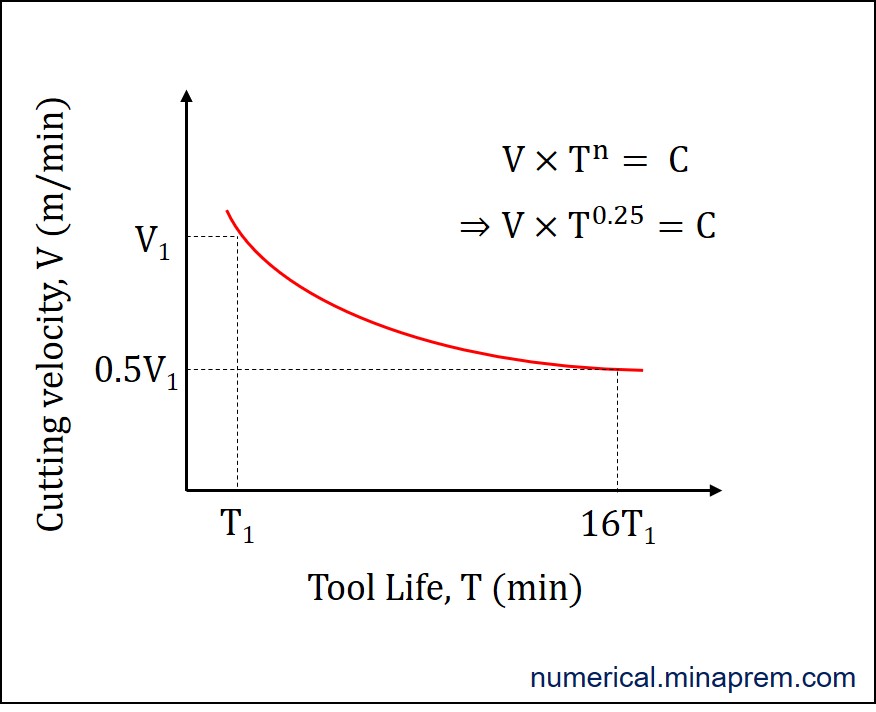This problem can be solved using well-known Taylor’s Tool Life equation which provides the exponential relationship between cutting velocity and tool life. The generalized form of Taylor’s Tool Life equation is shown below. The V indicates cutting velocity (m/min), T indicates tool life (min), n is one unitless constant called Taylor’s Exponent, and the C is another unitless constant known as Taylor’s Constant.
\[V{\left( T \right)^n} = C\]
Step-1: Formulate the problem to apply Taylor’s Tool Life equation
In the question, two combinations of velocity and tool life are provided. Let us first designate the cases through suffixes 1 and 2. So the followings can be written based on the given scenario.
(i) Say, T = T1 when V = V1
(ii) T = T2 = ? when V = V2 = (V1 / 2)
In these two cases, the tool material, workpiece material, feed, depth of cut, and cutting environment are unchanged. Accordingly, the value of constants n and C will remain same for the two cases. Hence, the following two equations can be written by applying Taylor’s Tool Life equation for the two cases.
\[{V_1}{\left( {{T_1}} \right)^n} = C\]
\[{V_2}{\left( {{T_2}} \right)^n} = C\]
Step-2: Calculate increment in tool life when cutting speed is halved
For the same C value, the left hand sides of the above two equations can be equated. In the question, the Taylor’s tool life exponent value is given n = 0.25. Therefore, the relation between T1 and T2 can be easily established by solving as shown below.
\[\begin{array}{l}
{V_1}{\left( {{T_1}} \right)^n} = {V_2}{\left( {{T_2}} \right)^n}\\
\left( {\frac{{{V_1}}}{{{V_2}}}} \right) = {\left( {\frac{{{T_2}}}{{{T_1}}}} \right)^n}\\
\left\{ {\frac{{{V_1}}}{{\left( {\frac{{{V_1}}}{2}} \right)}}} \right\} = {\left( {\frac{{{T_2}}}{{{T_1}}}} \right)^{0.25}}\\
2 = {\left( {\frac{{{T_2}}}{{{T_1}}}} \right)^{0.25}}\\
\left( {\frac{{{T_2}}}{{{T_1}}}} \right) = {\left( 2 \right)^{\left( {1/0.25} \right)}}\\
\left( {\frac{{{T_2}}}{{{T_1}}}} \right) = 16\\
{T_2} = 16{T_1}
\end{array}\]
Therefore, the tool life will increase 16 times if the cutting speed is halved.
Now the intended solution is obtained. Progressing further into the question, it is not possible to calculate the value of constant C from the given data. However, the typical variation of the tool life curve in a V-T plot can be drawn, as shown below.
